RADIATOR BUYING GUIDE
RADIATOR BUYING GUIDE
Introduction
Radiators are the most common way to heat homes in the UK. And getting the right ones can help make a home more energy-efficient, more comfortable to live in, and they can even enhance the decor. But with so many different radiators available, it can be hard to know what the best type of radiator to buy is.
In this comprehensive guide, we cover the types of central heating radiators available, their styles and materials, how to calculate radiator BTU and what you need to consider before buying a radiator.
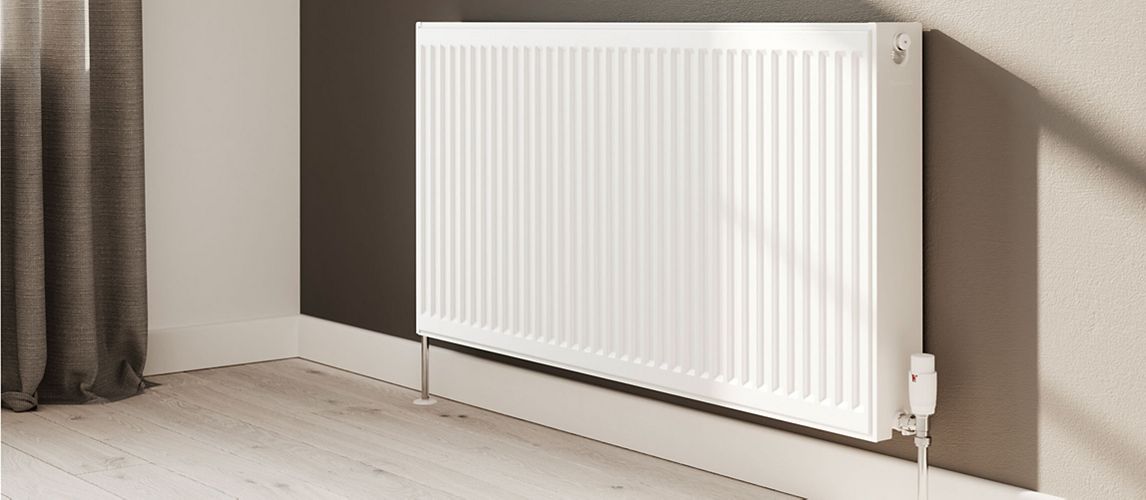
Types of Radiator
There are many different types of radiators available to suit different situations. First, you need to choose radiators based on the fuel type they will be used with. Then choose between the different styles and materials they are made of. Find the different radiators explained below.
There are four types of radiator heating:
Plumbed - Central Heating Radiators
This is the most common type of radiator found in UK homes. Plumbed in radiators are hollow metal panels with water flowing through them. Water is heated by a boiler, heat pump or solar thermal heating system and pumped around the radiators through connected pipes.
Electric Radiators
Electric radiators are hollow metal panels filled with a thermo-fluid warmed by a heating element that’s wired or simply plugged into the mains electricity supply. They’re often used in homes without a fuel supply. They are also ideal for new extensions, loft conversions or conservatories where there’s no plumbing. As they are controlled individually, they’re great for the summer months when it might only be necessary to heat a single room rather than the whole house.
Dual Fuel Radiators
Dual fuel radiators use both gas and electricity to run. They work like plumbed radiators but have the added advantage of an electric thermostatic heating element installed. This allows a single radiator to be heated without turning the plumbed central heating system on and heating the whole house, saving energy.
Oil-filled Radiators
As the name suggests, oil-filled radiators are hollow metal panels filled with oil heated by a heating element. They run on electricity and are a practical, low-cost heating solution and a great way to get heating on demand. Oil radiators retain and radiate heat for a long time after they’re switched off, so they use less energy. Like electric radiators, they are controlled independently, allowing more flexibility than plumbed in radiators.
When searching for radiators, you’ll hear the terms ‘single convector radiators’ and ‘double convector radiators’ a lot. So, you may be wondering, what is a convector radiator? And what is the difference between single and double convector radiators?
What is a Convector Radiator?
A convector radiator is made up of metal panels with a set of convector fins at the back that increases the surface area to raise the radiator’s heat output. There are a few different types of convector radiators. They are named depending on how many panels and fins they are made up of.
The numbering system is the best way to remember the difference between type 21 and type 22 radiators and how they differ from type 11. The first number represents the number of panels the radiator has. The second number represents the number of fins (e.g., type 11 has one panel and one fin, type 22 has two panels and two fins). A radiator with a bigger number of panels and fins will have a higher heat output than one with fewer panels and fins.
What are the three most popular types?
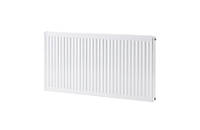
Type 11 - Also known as single panel convector radiators, these radiators consist of one metal panel with one set of fins.
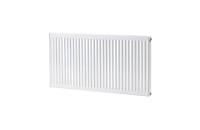
Type 21 - Also known as P+ radiators or double panel plus radiators, these radiators consist of two metal panels, sitting back-to-back, joined with one set of fins.
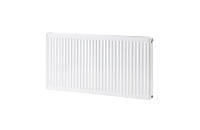
Type 22 - This is another type of double panel convector radiator. It also consists of two metal panels sitting back-to-back, but two sets of fins join the panels together.
Radiator Styles
Radiators come in many styles. First consider the size and type of the room it will go in. A ‘typical’ horizontal panel radiator may be perfect for a bedroom where visitors won’t see it. A designer radiator could work as a decorative feature in a living room. And a space-saving or vertical radiator is ideal for a kitchen with limited available wall space.
Here are the different types of radiators available:
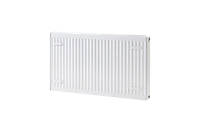
Single/Flat Panel or Double Panel Radiators - These are the most commonly used radiators for central heating systems. Central heating radiators come as either one slim single panel that fits closely to the wall or double panels with a gap between them that helps give out more heat.
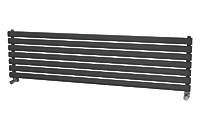
Horizontal or Vertical Radiators - Horizontal radiators are wider than they are tall and are commonly installed under windows. Vertical radiators, on the other hand, are taller than they are wide. As a result, they are great space savers. And, as they are more visible than horizontal radiators, they tend to come in more decorative designs.
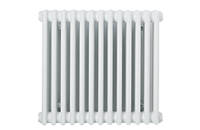
Column Radiators - Column radiators are made up of a vertical row of metal tubes joined at the top and bottom. They can come in horizontal and vertical designs and are usually more traditional than flat panel radiators.
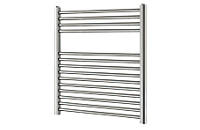
Towel Radiators - Towel radiators are the best radiators to buy for bathrooms. They are made up of a series of tubes arranged horizontally in a ladder style. They are perfect for hanging towels to keep them warm. Towel radiators are also more decorative than a standard flat panel radiator.
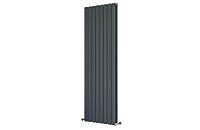
Designer Radiators - Designer radiators are often known as modern or contemporary radiators. They offer heat and warmth in stylish designs that can be a focal point in any home. You can buy horizontal, vertical, column and towel radiators in a designer style. And they come in lots of different finishes.
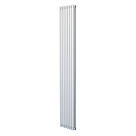
Space-Saving Radiators - Many of the other radiator styles come in space-saving designs. For example, a small single flat panel radiator sits close to the wall, thus not sticking too far out into the room. Likewise, a vertical radiator can save wall space where furniture or kitchen cabinets need to be placed. And some designer radiators can make use of narrow spaces as well as being a design feature.
Radiator Materials
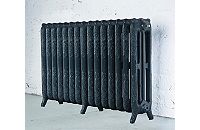
Radiators are made of one of four types of metal:
Mild Steel Radiators -
The majority of radiators are made from mild steel. It’s anti-corrosive, durable and recyclable. And the steel stays warm long after the radiators are turned off. Mild steel radiators are also the cheapest radiators to produce and the cheapest to buy.
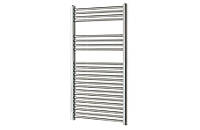
Stainless Steel Radiators -
Stainless steel is a popular material for towel radiators because it doesn’t corrode or rust, making it very long-lasting. It also heats up quickly and keeps its heat long after the heating is turned off. Stainless steel is cheap to produce and can be an affordable option.

Aluminium Radiators -
Aluminium radiators are the best radiators for heat output because the metal is a superconductor. As a result, it heats rooms quicker and more efficiently than any of the other materials. However, it cools down very quickly too, unlike the other radiator materials that keep their heat long after the system has been turned off. It’s also anti-corrosive, durable and recyclable. The benefit of aluminium is that it’s lightweight, so it’s perfect for installation on an internal stud wall.

Cast Iron Radiators -
Cast iron radiators take a long time to heat up, but they also stay warm for much longer than other materials. This makes them ideal for big rooms with high ceilings. However, cast iron is heavy, so floors and walls need to be structurally sound when installing these radiators. They can be considered a luxury radiator.
What Size Radiator do I Need?
Radiators come in many different physical sizes. However, when working out which size you need, you must also look at its BTU rating.
What is a BTU rating?
BTU stands for British Thermal Units, and it’s a measure of how much energy it takes to heat 1lb of water by 1ºF. All plumbed in radiators are given a BTU rating to tell you how much heat they produce. It doesn’t always follow that a large radiator will give out more heat than a smaller radiator because the heat output also depends on the material it’s made of.
To buy a radiator with the right BTU number, work out the number of BTUs the room needs first. That number will depend on:
- Which room it is
- Number of external walls in the room
- Quality of insulation in the room
- The size of the room
- The size and type of any windows and doors
A small cloakroom with no windows or doors, for example, will need a radiator with a much smaller BTU than a large, frequently used room with floor-to-ceiling windows and doors.
How Many Radiators do I Need?
To work out how many radiators you need, calculate the BTU the room needs first, then match the BTU requirement for the room with the BTU rating of the radiator. If you can’t find one that matches exactly, go for one that is slightly higher – the heating can always be turned down if it gives out too much heat.
In some cases, you may need more than one radiator. For example, in a large room with high BTU requirements, even a radiator with the highest BTU rating might not be enough to heat it adequately. Or you may want to install more radiators to distribute the heat around a large room more evenly. Whatever the reason, if you need to install more than one radiator in a room, ensure the total BTUs for all radiators add up to the BTU requirement for the room.
Radiator Replacement
Radiator replacements can be carried out by a competent DIYer or a tradesperson depending on the job complexity. If pipes need to be moved or installed, we recommend using a qualified plumber. If any of the work involves the boiler, a gas-safe engineer must be used. Likewise, any mains electrical work must be carried out by a qualified electrician.
Before replacing a radiator, there are a few things you need to check:
Does the radiator need replacing?
Over time, radiators can build up sludge that affects their efficiency and heat output. If the radiator is showing any of these signs, it may need replacing:
- It’s noisy – gurgling sounds from a radiator are common. This could indicate trapped air in the system which would require bleeding, but listen out for other unusual noises.
- It’s slow to warm up – try bleeding the radiator. If that doesn’t work, or you find you have to bleed it often, it may have too much sludge built up inside that’s restricting its water flow.
- It’s leaking water – if water is leaking from a valve, then the radiator may only need a valve replacement. But if water leaks from the radiator panel itself, it will need to be replaced.
- Water or fuel bills have increased – if utility bills have increased without using the radiators more often, then a build-up of sludge inside the radiators may have made them inefficient
Check existing radiator pipework
If you’re replacing plumbed in radiators, look at where the existing pipework runs. If it runs along the wall, it will be easier to adjust if you choose a radiator that’s a different size to the current one. However, if the pipes come up through the floor, it will be a much bigger job to install a different sized radiator since flooring will need to be pulled up to adjust the existing pipework.
What to do before replacing a radiator
- Consider the type of wall the radiator will be placed on. If it’s a stud work wall, you’ll need to ensure the radiator is mounted to the wooden studs and not only to weak plasterboard.
- Check the wall is sound, whether the wall is brick, masonry or stud work, the wall’s surface must be sound to ensure the mounting brackets will be firmly screwed in place and take the weight of the radiator.
- Ensure the radiator/s have the correct BTU for the room.
How long does it take to install a radiator?
The length of time it takes to install a radiator can vary depending on the type of radiator being installed, how much work is involved and the installer's skill level.
As a guide, on average, a professional tradesperson will take around two hours to install one large radiator. And as large radiators can be heavy and awkward to carry, they may use a labourer to help them.
If the job is more complicated, for example, if they have to lift floorboards and move pipes, then it will take longer.
Radiator Valves - What You Need to Know
All plumbed in radiators need radiator valves to work because they control the heat output of the radiator. There are different types of radiator valves available:
Manual Radiator Valves
These are the most traditional radiator valves available. As the name suggests, they are operated manually by hand by turning them like a tap. These valves allow the radiator to be turned off or on.
Thermostatic Radiator Valves (TRVs)
TRV valves are also operated by hand. However, they contain a thermostat that measures the temperature in the room. So instead of only turning the radiator off or on, you can control the temperature on each radiator individually.
Lockshield Radiator Valves
Lockshield radiator valves connect to the radiator and control the amount of water that flows out of the radiator and into the return pipework. It also allows the radiator to be “balanced”, meaning that the water is evenly distributed across the property ensuring that all of the radiators heat up at the same time.
Smart Radiator Valves
These valves are more advanced than the other types of valves. They can be operated manually or be connected to Wi-Fi and controlled through a smart tablet or phone. They allow the user to create zoned heating and have other smart functions such as detecting an open window, scheduling, and controlling the heating from anywhere.
Angled or Straight Radiator Valves
As well as considering what type of valve you need, you also need to know how the valve will be connected to the radiator. And this depends on where the valve inlet is on the radiator itself.
- Side connection – these valves enter the radiator on both sides, close to the bottom.
- Underside connection – these valves enter the radiator from underneath, at each end or in the middle.
You’ll then need to consider how the radiator valves will be connected to the pipework and, therefore, if the valves will need to be straight radiator valves or angled radiator valves as follows:
- Side connections with pipes coming up from the floor: use angled valves.
- Side connection with the pipes coming out of the wall: use angled valves.
- Underside connections with the pipes coming up from the floor: use straight valves.
- Underside connection with the pipes coming out of the wall: use angled valves.
Maintenance of Radiators
Radiators are often one of the most reliable features of a home and can last for decades, with little maintenance needed. Electric and oil-filled radiators don’t need any maintenance at all.
However, for plumbed in radiators, two things can be carried out to keep them working efficiently:
Bleed radiators once every year
Even though radiators are a closed system, air can still get into them through the water. This air builds up and creates a pocket at the top of the radiator that doesn’t heat up. So, once a year, bleed the air out by turning the small screw on the top right-hand side of the radiator.
Heating service including radiators once a year
It is advised that a Gas Safe Registered engineer service your boiler every year to ensure that your system is working well. This is a legal requirement for landlords.
Power flush the central heating system every 5-6 years
Pipes in a central heating system will slowly corrode over many years. This forms a sludge that travels around the system, blocking or restricting the hot water flow and reducing the efficiency of the radiators. A qualified plumber can flush chemically treated water around the circuit at high pressure to remove all debris to prevent this from happening.
5 Considerations When Getting New Radiators
It’s always important to do your research before getting new radiators to ensure you’re getting the right product for the room it’s needed for and that it’s properly installed.
Here are three things to consider:
Location
The best place to install a radiator is in the coldest part of the room. This is often under a window. However, with modern double-glazing, that might not necessarily be the case.
So, when deciding where else you could put it, you could consider:
- The wall type – a solid masonry or brick wall works well because it is strong. Whereas a stud work wall covered in plasterboard will be too weak, so you’ll have to ensure the radiator brackets are fixed to the wooden studs.
- Furniture – avoid hanging the radiator where you want to place large pieces of furniture as the furniture will block the heat from travelling easily around the room.
- An outside wall – outside walls tend to be cold, so a lot of heat from the radiator will be absorbed by the wall. To prevent this from happening, install a heat reflector behind the radiator before hanging it. This will reflect the heat back into the room.
Heat output
The most important thing to consider when buying a radiator is its heat output. In Britain, heat output is measured in BTUs (British Thermal Units), and every central heating radiator is given a rating. Use a BTU calculator to work out what heat output the room needs. Then match the BTU number given with the BTU of the radiator. You can get to the required BTU for the room with just one radiator or add up the BTU of more than one radiator to get to the right amount of heat output that’s required.
Heating elements
An electric heating element is a small device that goes inside a radiator to heat it up without turning the whole central heating system on. It can be added to plumbed in radiators to turn them into a dual fuel radiator.
There are four types of heating elements available:
- Fixed temperature heating element - These elements are fixed at 65º and are controlled from a wall switch.
- Thermostatic element – These elements have multiple heat settings, allowing greater flexibility over the temperature.
- Low surface temperature element – These elements are programmed to run at 43º, thus ensuring the surface of the radiator can be touched without causing harm. They are ideal for households with young children or elderly people.
- Smart element – These elements are controlled by a smartphone or tablet, via a Bluetooth connection. They are thermostatic, so they have multiple heat settings, and they also have timer functionality.
Central heating inhibitors
Heating inhibitor is a chemical solution that’s added to a central heating system. It coats the inside of radiators to prevent corrosion which can cause a build-up of sludge and debris. Adding radiator inhibitor to a new radiator is vital. Not only does it keep the radiator working efficiently, but it also protects the boiler from damage. Shop our range of central heating inhibitors and protectors.
Radiator balancing
Radiator balancing is when all the radiator valves within a central heating system are adjusted to ensure the water flow through the system is level, and the radiators heat up evenly.
In a current central heating system, the radiators are likely to already be balanced. However, if you are adding an extra radiator, it’s vital that all the radiators in the system are balanced to prevent both radiator and boiler damage. This can be achieved by bleeding the radiators, listing, testing, identifying, and adjusting accordingly to ensure they’re all heating up at roughly the same rate.
Radiator Accessories
Once radiators are installed, some great accessories can be added to enhance their look and functionality:
Radiator covers and cabinets
If you’ve installed basic panel radiators, they can be covered up and turned into a stylish feature with a radiator cabinet. The cabinets are made from MDF which can be left as they are or painted in a colour to suit the room’s décor. They also provide a handy shelf above the radiator that can display ornaments or be used for storage. Radiator covers and cabinets also keep young children safe from hot radiators.
Radiator boosters
A radiator booster is an electrical device that’s a long rectangular tube with a fan inside. The booster sits on top of the radiator. When it’s switched on, it disperses the trapped warm air from behind the radiator around the room. This makes the radiator more efficient and helps warm up the room quicker.
Radiator paint
Designer radiators come in many colours now. But if you’ve opted for a standard white radiator, you can personalise it by painting it in a colour to suit your décor. You can buy specialist radiator paints, but a standard emulsion, gloss or satin paint will work equally as well with a clear radiator overcoat on top to avoid blistering/peeling.
Top Tips When Buying a Radiator
How to measure a radiator
If you want to replace a radiator with a like-for-like model, it’s important to measure the old radiator correctly. Here’s how:
- Take all the measurements in millimetres
- Measure the radiator height
- Measure the radiator width
- Measure the distance between the centre of the left pipe to the centre of the right pipe
- Measure the distance between the wall to the centre of the pipe
Removing a radiator
Removing a radiator is a relatively simple job to do, but remember to:
- Have someone ready to help you – radiators can be heavy
- Close the radiator valves
- Drain the radiator before you start
- Place plenty of towels and a bucket beneath the radiator, ready to catch leaking water.
Painting a radiator
To get the best paint finish, remember to:
- Turn the radiator off long before you start – a radiator must be painted when it’s cold.
- Sand it down and clean it before painting to ensure the paint sticks well.
- Prime it with a metal primer or specialist radiator primer.
- Paint it with a specialist radiator paint or use emulsion, then apply a clear radiator topcoat.
